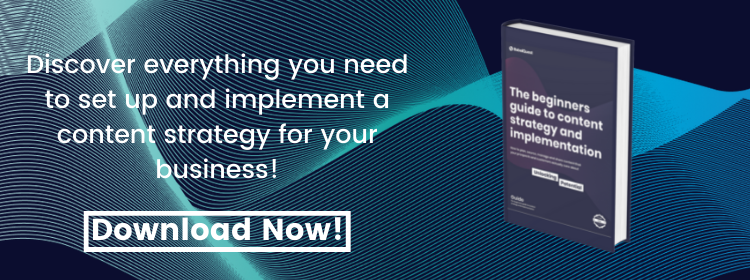Discover where to get innovative content marketing blog ideas that actually work and help your marketing to hit its goals and grow the business.
Last week I was speaking with a marketing manager whose content machine had run into some roadblocks. When I say 'content machine', I mean his content strategy. And when I say 'run into some roadblocks', I mean ground to a halt.
According to this person, it wasn't that he had run out of ideas. It was that his ideas weren't working. He meant this objectively; the content his team was producing was well-researched, well-written, and promoted to their target buyers.
It just wasn't delivering the results he needed.
I know how frustrating it can be trying to inspiration for editorial calendars, never mind content ideas that make a lasting impact.
In my experience, the solution to finding content ideas that deliver is to leverage the insight of both the wider business and your sales and marketing technology.

Get content marketing blog ideas from your sales team
One of your first ports of call when looking for winning ideas to inform your content strategy should always be your sales team.
Salespeople are absolute goldmines for content ideas — particularly those that will improve sales performance. Whether you end up speaking to sales people individually or in a group meeting, here’s how you can collect their thoughts and ideas quickly and effectively.
1. Ask them what content they want
Dive straight in. It’s likely that they’re struggling to fit the content you’re producing into their introductory and follow-up emails — or they might not even be aware of the content you’ve created.
Run through the content already available to them and ask if there’s anything missing, or if there’s something in particular that could really help them close a deal faster. Put yourself in the position where you're helping them to do their job better.
I can guarantee there will have been times when a member of the sales team has said ‘I really wish I had xyz to send to this prospect!’, so get them to share these insights with you.
2. Get them to share customer and prospect questions
Ask them to bcc you into their email correspondence so you have a constant stream of ideas for blog titles. This is also a great way to find out which questions keep coming up. When you find one, craft an article to answer it and encourage your sales team to link to it in their emails.
It’s likely that they’ll have a few different ways to answer the question, and you can improve your article based on their feedback. Doing this will also save them time, and they’ll be able to see the benefits as soon as they’ve used your article in their emails.
Of course, there’s every chance they might not be too comfortable sharing their emails with you — so an alternative could be ask them to send you a list of all the questions they were asked that day, week or month. This is a little more time consuming, so point out that bcc’ing you is the quicker option.
3. Schedule meetings for sales and marketing alignment
This is another one that is dependent on time, but if both sales and marketing teams are able to schedule a meeting once a week (or even once a month) it will help to keep everyone up-to-date and provide another opportunity to surface new content ideas.
Sales and marketing alignment meetings are also a great place for both teams to discuss:
-
The efficiency of the sales process
-
Lead scoring and sales qualification
-
Mapping your existing content to the different stages of the buyer’s journey
-
How well specific pieces of content are performing
-
If any improvements can be made
Sales and marketing teams should aim to be in constant communication with each other. That way, you can always ensure you’re all working together towards the same goal.
Getting innovative content ideas out of the rest of the business
In my experience, you can learn a great deal from other departments in your business. Support and service delivery departments will always have a wealth of questions and expertise that content creators can use to make more informed decisions. They know your customers better than anyone, and they’ll be aware of any issues your prospects may face when they begin their onboarding process with you.
Leveraging these departments will also allow your writers to be transparent about your business in the content they produce, in turn helping you to build trust. If you can answer a prospect’s concerns about your products or services in an honest and accurate way, they’ll be more likely to become a happy customer.
Organising a content workshop
One way to help secure buy-in for your inbound marketing strategy is to ask everyone to come up with new content ideas and get them involved in the writing process.
We believe that the best way to do this is to organise a content workshop. Marcus at The Sales Lion has found that ‘On average, a company that starts their content marketing campaign off with a workshop achieves over 300% more growth in traffic, leads, and new customers than a company that does not.’
This can be department or company wide, depending on the scale of your organisation. Here are a few frequently asked questions on putting together a successful content workshop and ensuring you come away with lots of great content marketing ideas.
Q: How long does a content workshop take?
In our experience, a small company of 10-20 employees can usually get through everything in half a day, but for larger organisations, you may need to book out one to two days to keep team sizes manageable. Schedule enough time to run through everything you need to and answer any questions your colleagues may have.
Q: What do you need to run the workshop?
For a workshop to be successful, you’ll need to have a clear idea of what you want to cover, so it helps to create a presentation to keep you on track. At a minimum you should include:
-
An explanation of how the power has now shifted to the buyer
-
An introduction to inbound
-
A short explanation of how Google and other search engines work
-
A brief overview of the buyer’s journey with examples of content for each stage
-
A list of the benefits for both the business and the staff
-
An explanation of what you are looking for and what you hope to achieve
-
Your smart goals
Q: What will I need on the day?
-
A laptop and projector screen
-
Separate areas for small teams to work (if relevant)
-
A whiteboard or flip-chart and different coloured markers to write down ideas
In our experience, starting a workshop over the lunch period is a great way to get the team together. Order in some pizza or ask your colleagues to contribute to a buffet as this will help to get people engaged and excited about your workshop.
If your workshop is going to run over one or two days, make sure that you have scheduled time for coffee breaks, so that you can all stay focused on the task at hand.
Q: What outcomes will you get from a content workshop?
This depends on what you want to achieve. If you are simply looking for a way to get questions and ideas out of your colleagues, then this will really help, but you’ll be missing out on some serious opportunities for success.
During the session, try to get your colleagues to put themselves in your buyer's shoes. What would they be likely to search on Google? Which social media sites would they be most likely to use? By considering these details as well as pulling out common pain points and questions, you will be better positioned to join the buyer's journey at an earlier stage.
You should also get everyone to create a list of all the questions they can think of surrounding your products and services. Every single one of these is a potential blog article and will help you to think from a different perspective which will be more useful to your prospects than specifications.
But why stop there? If you’re lucky enough to have a team who are really enthusiastic about what you’ve just taught them, why not ask them to draft the articles themselves? That way you’ll have a steady stream of content waiting to be edited and then published.
If you think this could work for your business, make sure you set out some clear tone of voice guidelines first, so that the articles are consistent.
If you’re thinking, ‘This sounds great! But I’m not sure it’ll work for us’, tell us why, and we’ll do our very best to help you make it a success.
Assume the journalist position
Whether you're interviewing sales, customer service, or John from Product Innovation, it helps to be able to get the information you're looking for as quickly as possible. And if you ask the right questions, you could find yourself privy to more than just customer queries and support questions.
The power of storytelling can transform the effectiveness of your content. By taking the time to engage someone from further afield than marketing or sales, you're creating opportunities to listen for those stories. If you listen closely, and if you have an ear for it, you might just hear something that will resonate with your readers.
Stories engage us in a way that information, facts, and statistics can't. They generate empathy and put the listener or reader in other people's shoes. That's incredibly powerful, especially when you've got your content cap on.
Some tips for sourcing stories:
- Who are the experts? The movers, the shakers, the product makers? (John, that means you.) Experience often comes hand-in-hand with stories.
- Confidence is key. Don't be intimidated by seniority, although I appreciate that's easier said than done. Often, your founders are at the heart of your company's brand story. Learn how to carry yourself in an interview.
- Record, record, record! Whether you're producing a full-scale interview recording for video marketing purposes or you want to catch all the details of an audio for transcription later, consider how you're going to do this. (Always ask permission before recording someone.)
How to come up with content ideas using technology
Ideas are one thing, but if you remember back to the start, we're looking for ideas that work. It's one thing to tap up other departments for their insights and stories, but to come up with content ideas that translate into results you can shout about, you need data.
There are shedloads of digital marketing tools and sales software you can use to find this kind of information. (The CRM is one we've already touched on.) Our favourite is SEMrush, which we use to enrich our editorial and website copy for organic search and make sure that the sales assets we create are better than those being offered by our competition.
We won't give all our secrets away, but in SEMrush's own words:
Which keywords are the best for SEO? What are the best ways to perform PPC keyword research and choose the best keywords for AdWords or Bing Ads? How do you find the appropriate keywords for your target audience?
With the SEMrush Keyword Research feature, you can easily answer all of these questions.
- Discover well-tried and tested keywords—the ones that help your competitors’ and industry leaders’ websites rank in Google's and Bing's top results.
- You'll get extended information on their value for organic and paid research. For every keyword that’s present in our databases, you’ll get useful information such as: CPC, volume, the number of results, trend, and ad copies for the queried term.
- You’ll also discover which of the biggest web players use each keyword, and their most popular landing pages.
-
Finally, you’ll be able to analyze this data for both desktop and mobile index.
Backing your content ideas with search volume, keyword difficulty ratings, and objective research into the quality and form of the content your competitors are creating enables you to make more informed decisions on your content strategy, never mind how your sales and marketing teams set about creating that content.
Discover how to create and publish standout content in 5 simple steps.
How to come up with content ideas on your own
If you're a one-man band, a new business, or the rest of the company simply won't play ball (we've all been there), it's still possible to come up with content ideas on your own.
- Look at your customer persona's reading habits. What content formats do they prefer? What style of content do they value — tactical ‘how to’ articles or more strategic, conceptual pieces? Technology like Buzzsumo can be used to find out which content types your personas engage with and share the most.
- Review what your competitors are doing. If you share a similar target audience, check out what content they are producing and how well it is being engaged with.
- Carry out SEO analysis and review. Undertake keyword research using Google Search Console to identify which queries users typed into Google to find your website. Google autocomplete also offers suggestions for queries as well as related searches, visible at the bottom of the search results page.
- Look at what your existing customers and prospects are doing (and looking for). What are they engaging with over social media? What content have they engaged with? This is where integrated marketing tools such as sales and marketing platform HubSpot can prove invaluable, revealing objectively how your target buyers are moving around, and engaging with, the site. Survey or interview your customers and prospects to find out what content they would be interested in.
Become a content marketing idea generator for your business
When most people hear 'content idea generator', they think of technology shortcuts. But if you follow the above steps, you will quickly find that the best ideas are those combining key data insight with ideas and inspiration from the rest of the business.
Content today is as much data as it is the art of business storytelling; find the sweet spot between what captures your reader's interest and what performs well according to your goals.
Learn how to turn your content ideas into articles and videos your customers love using 'The Beginner's Guide to Content Strategy and Implementation.' Download your free copy below.
Heading
Separated they live in Bookmarksgrove right at the coast of the famous Semantics, large language ocean and many more stuff and more more more


Tom is BabelQuest's Principal Copywriter. He has a PhD in Creative Writing from the University of Southampton and is a novelist with Sparkling Books.




.png?width=50)

.png?width=50)
.png?width=50)


































